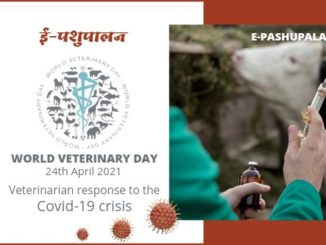WHO defines zoonosis as disease or infection that are naturally transmitted between vertebrate animals and human beings. It can be caused by any communicable disease agent like bacteria , virus and fungus. Control of the zoonotic disease makes coordination between veterinary and health service a prerequisite.
WHO reported that six out of ten infectious diseases is a zoonotic disease and three out of 4 emerging infectious disease is a zoonotic disease. The WHO/FAO/OIE joint consultation on emerging zoonotic disease held in Geneva, defined “emerging zoonosis as disease that is newly recognized or newly evolved, or that has occurred previously but shows an increase in incidence or expression in geographical, host, or vector”.
COMMON MODES OF TRANSMISSION OF ZOONOTIC DISEASE
DIRECT CONTACT: Contact with saliva, blood, urine, mucous, feces or any other body fluids of infected animals.
INDIRECT CONTACT: Coming in contact with areas where animals live and roam, or objects or surfaces that have been contaminated
VECTOR BORNE: Transmitted by vectors like ticks, fleas, and insects.
FOOD BORNE: Many diseases like salmonellosis will be transmitted by the consumption of under cocked meat and consumption of unpasteurized milk can lead to diseases like tuberculosis.
WATER BORNE: Drinking or coming in contact with water that has been contaminated with feces of an infected animal
The zoonotic disease effect both socially and economically
SOCIO-ECONOMIC IMPACT OF ZOONOTIC DISEASES: Each and every zoonotic disease might have a different kind of impact. so in this article I have tried show the social and economical impact of three major zoonotic diseases.
1.TUBERCULOSIS
2.BRUCELLOSIS
3.COVID19
TUBERCULOSIS
Tuberculosis is a serious disease of humans and animals caused by members of the family mycobacterium tuberculosis complex.
Tuberculosis is the most common human immune deficiency virus (HIV) related opportunistic infection and it causes acquired immune deficiency syndrome(AIDS)
India was one of the highest TB burdened countries in the world.
SOCIO-ECONOMIC IMPACT OF TUBERCULOSIS:
SOCIAL IMPACT OF TUBERCULOSIS:
- TB affects the society both directly and indirectly.
- Women are more likely to get affected with tuberculosis and are diagnosed less.
- The affected women will not be able to involved in households works while the major work in the household will be done by the women.
- The affected people will not be invited to any gatherings which can cause psychological stress.
- The affected individuals might loss their jobs and it can lead to economical crisis for the family.
ECONOMICAL IMPACT OF TUBERCULOSIS:
- Government was spending around 5.8 million dollars on notifiable tuberculosis cases.
- An economist stated that “TB is a relentless leveler , an equal opportunity killer, hard-working and persistent going about its deadly business with cool disregard for IQ , sex, class, race, occupation, or even geographical boundries ”
- The impact of the TB was seen mostly in developing and under developed countries, since the people will be living in crowded areas.
- While talking about the economical impact of the tuberculosis the main thing that comes into mind is the cost of treatment, but to be practical the earnings lost from the illness and death will be much greater.
- In India individuals who received treatment are estimated to lose around two months of time.
BRUCELLOSIS
Brucellosis is one of the most common zoonosis world wide, causing huge economic loss world wide and posing a serious threat to human health. Only some developed countries have achieved freedom over brucellosis. The transmission of brucellosis occurs by direct contact with the infected animal or contact with secretions.
SOCIO-ECONOMIC IMPACT OF BRUCELLOSIS:
- Many developed countries eradicated the brucellosis, but it was very common in under developed and developing countries.
- In affected animals milk production will get decreased and it will lead to abortions, which was affecting the economy both directly and indirectly.
- Even though there was a huge socio-economic impact on milk production, infertility, sale value and dowry, it was the costs of treatment that was significantly impacted on all symptoms associated with brucellosis on this community . A one health approach in tackling the brucellosis menace as a holistic approach is recommended for both humans and there livestock.
- Effective control of brucellosis requires a long term commitment from many governmental agencies. Assistance from international animal and human health organizations.
COVID-19
COVID-19 is an infectious disease caused by severe acute respiratory syndrome corona virus2 (sars-cov-2). it was first reported at wuhan, china on December 2019 it spread all over the world and had affected more than 22 million people till date. It was the global health crisis of our time and greatest challenge we have faced since world war two. It caused unprecedent socio-economic crisis
SOCIO-ECONOMIC IMPACT OF COVID19:
Covid-19 have changed the way a zoonotic diseases were seen, it had changed the fate of whole world and lead to a huge economic loss which was not even imagined by any one.
ECONOMIC IMPACT OF COVID-19:
- COVID-19 has severely demobilized the global economy.
- In many affected countries to restrict the spread they have implemented complete lockdown which worked effectively for some countries.
- International trade and transport was completely restricted in many countries.
- In COVID-19 effected countries entire spiritual, educational, sports institutions are kept closed.
- Both international and domestic flights were canceled, while in some countries flights are available with some restrictions.
- The GDP of each and every country was dropped gradually.
- Many people around the world have lost there jobs which lead to unemployment.
SOCIAL IMPACT OF COVID-19:
- Iran, Jordan, Morocco, Oman, and Yemen banned the printing and distributing of news paper.
INEQUILITY
- Low income individuals are more likely to contract the corona virus and die from it since low income individuals are more likely to live in crowded places.
RELIGIOUS IMPACT
- Temples plays a very major role in India, due to covid-19 all the devotional institutions including temples were closed.
- Some fake babajis take this as an opportunity and spread some fake news regarding this and they influenced people to make money.
UNEMPLOYMENT
- Since every industry were closed, there was no production which lead to loss of many jobs.
- In some cases even though jobs were there people were not able to get since there was no work.
PSYCHOLOGICAL IMPACT:
- Families will play a very major role in psychology of a person.
- To restrict the spread of the disease in many countries complete lockdown was implemented.
- It psychologically affected the people who were living alone they were not able to share their feelings with anyone, which might have affected them psychologically, Many people committed suicide due to psychological stress.
ELDERRLY CARE:
- People above 60 years of age are comparatively more affected.
- The mortality rate was highest among people above 60 years of age so proper care should be taken to protect elderly people.
CONCLUSION:
- Recommendations based on the one health approach that could aid a coordinated multi-sectorial response to future pandemics include:
- Raising awareness of zoonotic diseases.
- Investing in interdisciplinary approaches including one health.
- Expanding scientific enquiry into zoonotic diseases.
- Improving cost-benefit analyses of interventions to include full-cost accounting of societal impacts of disease.
- Strengthening monitoring and regulation practices associated with zoonotic diseases, including food systems.
- Improving biosecurity and control, identifying key drivers of emerging diseases in animal husbandry and encouraging proven management and zoonotic disease control measures.
- Supporting the sustainable management of landscapes and seascapes that enhance sustainable co-existence of agricultural and wildlife.
- Strengthening capacities among health stakeholders in all countries, and operationalising the one health approach in land-use and sustainable development planning, implementation and monitoring, among other fields.
|
The content of the articles are accurate and true to the best of the author’s knowledge. It is not meant to substitute for diagnosis, prognosis, treatment, prescription, or formal and individualized advice from a veterinary medical professional. Animals exhibiting signs and symptoms of distress should be seen by a veterinarian immediately. |






Be the first to comment